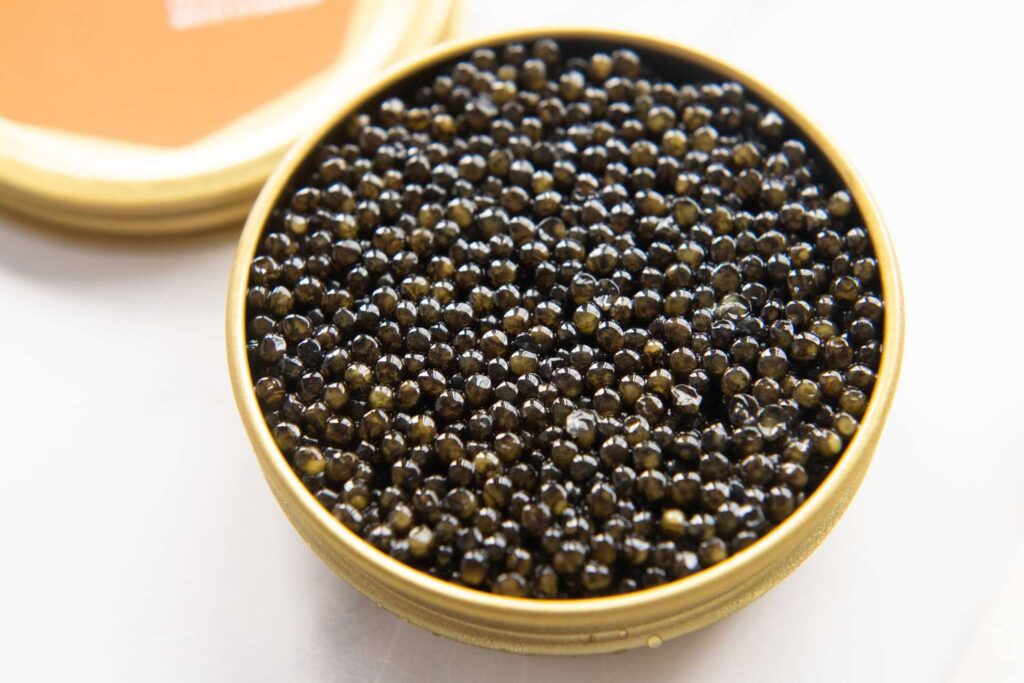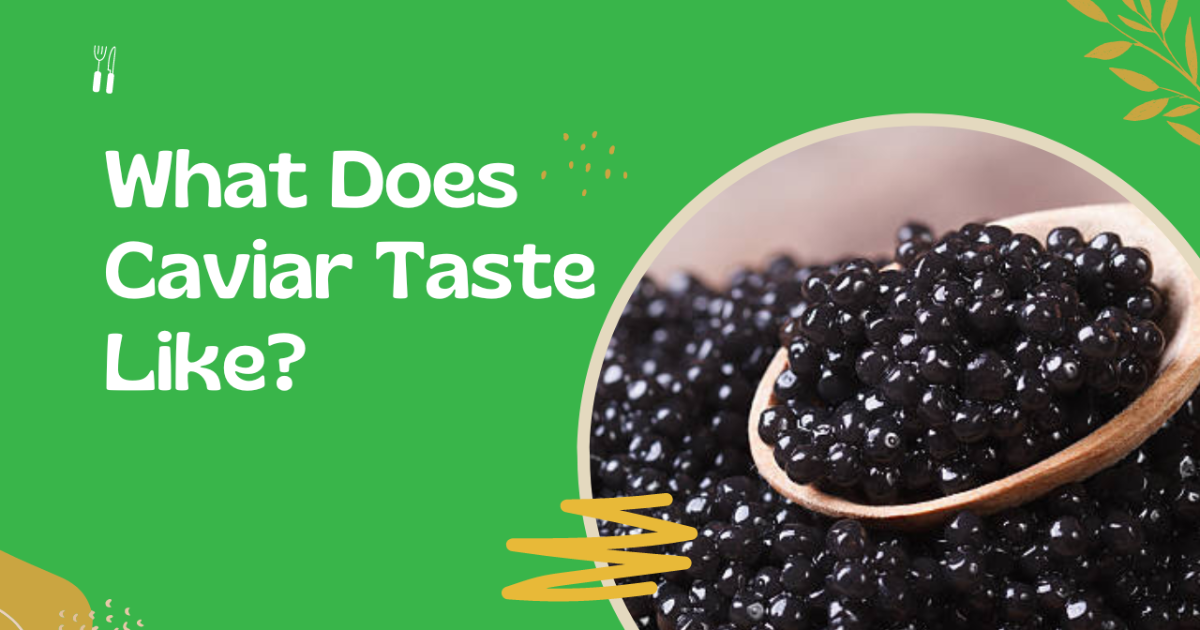Caviar, often associated with luxury and indulgence, is a delicacy that has captivated the taste buds of connoisseurs for centuries. Derived from sturgeon fish’s roe (eggs), caviar is highly regarded for its unique flavor profile and exquisite texture. In this article, we will delve into the world of caviar to understand what makes it so unique and explore what does caviar taste like.
What Does Caviar Taste Like?
Caviar is a delicacy highly regarded for its unique and luxurious taste. It is often described as having a rich, buttery, and slightly salty flavor. The texture of caviar can vary depending on the type and quality. Still, it is generally smooth and velvety, with each egg bursting in the mouth to release its distinct flavor. The taste of caviar can also be influenced by factors such as the species of fish, the processing methods, and the region it comes from. Overall, caviar offers a complex and indulgent taste experience that is highly sought after by food enthusiasts.
How To Eat Caviar?
To properly enjoy caviar, follow these steps: First, use a mother-of-pearl spoon or a non-metallic utensil to scoop a small amount onto your plate. Next, avoid using metal utensils as they can alter the taste of the delicate roe. Then, place a small bite-sized portion of caviar on your tongue. Allow the eggs to burst, releasing their rich flavors gently. Finally, savor the taste by slowly chewing and experiencing the caviar’s unique texture and briny taste. Pair it with traditional accompaniments like blinis, toast points, or crème fraîche for an enhanced experience.
Why Is Caviar So Expensive?
Caviar is considered a luxury food item known for its high price tag due to several factors:
- Caviar comes from the roe (eggs) of sturgeon fish, which are scarce and take a long time to mature. Sturgeon fish are also highly valued for their meat, making them even rarer.
- The process of harvesting caviar is labor-intensive and requires skilled professionals. The eggs must be carefully extracted by hand, cleaned, and sorted based on size, color, and quality.
- The demand for caviar exceeds the supply, especially for certain types like Beluga caviar, increasing prices.
Lastly, caviar has a limited shelf life and requires special storage conditions, adding to the overall cost. Overall, the combination of scarcity, labor-intensive production, high demand, and delicate nature contributes to the high price of caviar.
Different Types Of Caviar And Their Flavors

Several types of caviar are available, each with its unique characteristics and flavors. Here are some of the most popular types of caviar and their distinct flavors:
Beluga Caviar
Among most expensive caviar, Beluga caviar is considered the epitome of luxury and is often called the “king of caviar.” It is derived from the eggs of the beluga sturgeon, which can take up to 20 years to reach maturity. Beluga caviar is characterized by its large, glossy black eggs with a soft buttery texture. The flavor profile of beluga caviar is delicate and mild, with subtle hints of the sea and a creamy finish.
Osetra Caviar
Osetra caviar comes from the eggs of the Osetra sturgeon, a species native to the Caspian Sea and Black Sea regions. It is highly regarded for its medium-sized eggs, which range in color from golden yellow to dark brown. Osetra caviar has a complex flavor profile that can vary depending on the origin and processing methods. Generally, it offers a nutty buttery taste with a hint of saltiness and a smooth, creamy texture.
Sevruga Caviar
Sevruga caviar is obtained from the sevruga sturgeon, another species found in the Caspian Sea. It is known for its small-sized eggs, typically dark gray or black. Sevruga caviar has a bold and robust flavor profile with pronounced saltiness and a slightly tangy finish. The texture of sevruga caviar is firm and crisp, providing a satisfying pop when consumed.
Sterlet Caviar
Sterlet caviar is sourced from the eggs of the sterlet sturgeon, a smaller species native to the Caspian Sea and Black Sea regions. It is characterized by its small-sized eggs that range in color from light gray to golden brown. Sterlet caviar has a delicate and subtle flavor profile, mild saltiness, and creamy texture. It is often considered a more affordable alternative to other types of caviar.
Hackleback Caviar
Hackleback caviar, also known as shovelnose caviar, is derived from the eggs of the hackleback sturgeon found in the Mississippi River and its tributaries. It features small-sized eggs that are dark gray to black. Hackleback caviar has a rich and earthy flavor with a hint of sweetness and a buttery texture. It is often considered a more accessible option for caviar enthusiasts.
Different Colors Of Caviar And Their Meaning
Caviar comes in various colors, each with its unique characteristics and flavors. While the color of caviar does not necessarily indicate its quality or taste, it can provide some insights into the type of sturgeon species it comes from and the processing methods used.
- Beluga Caviar: Known for its large, soft eggs and rich flavor, it is typically gray or black. It is considered the most luxurious and expensive type of caviar.
- Osetra Caviar: Osetra caviar comes from the Osetra sturgeon and can range in color from golden yellow to dark brown. The color is influenced by the sturgeon’s diet, with a lighter color indicating a diet rich in algae and a darker color showing a diet of crustaceans.
- Sevruga Caviar: Sevruga caviar is smaller in size compared to beluga and osetra caviar. It is usually gray or black and has a slightly saltier taste.
- Sterlet Caviar: Sterlet caviar comes from the sterlet sturgeon and is known for its small, golden eggs. It has a delicate flavor and is often considered a more affordable alternative to other types of caviar.
- Kaluga Caviar: Kaluga caviar, also known as River Beluga, is similar in appearance to beluga caviar but comes from a different species of sturgeon. It has large, glossy black eggs with a buttery flavor.
- Hackleback Caviar: Hackleback caviar comes from the shovelnose sturgeon and has small, jet-black eggs. It has a nutty flavor and is often considered a more budget-friendly option.
How Does The Taste Of Caviar Differ By Color?
The taste of caviar can vary slightly depending on its color. Generally, caviar comes in three primary colors: black, golden, and red. Black Caviar, the most common and sought-after type, has a rich buttery flavor with a hint of saltiness. It is often described as having a smooth and creamy texture. Golden caviar, also known as albino caviar, is milder in flavor than black caviar. It has a delicate and nutty taste with a slightly sweet undertone. Red caviar, typically sourced from salmon roe, has a distinct briny flavor that is less salty than black caviar. It is often described as having a fresh and crisp taste with a pop of umami. The color of caviar does not solely determine its taste; factors such as the species of fish, processing methods, and quality also play significant roles in the overall flavor profile.
Why Does Some Caviar Taste Different Than Others?
Caviar can taste different from one another due to several factors. The primary factor is the species of sturgeon from which the caviar is sourced. Other sturgeon species, such as Beluga, Osetra, and Sevruga, produce caviar with distinct flavors and textures. Additionally, the age and size of the sturgeon at the time of harvesting can affect the taste. Younger sturgeons tend to produce milder and creamier caviar, while older ones may yield more robust and complex flavors. The sturgeon’s diet also plays a role in determining the taste of caviar. Sturgeons that feed on a varied diet in their natural habitat may produce caviar with more nuanced flavors than those raised in controlled environments. Lastly, caviar producers’ processing and handling methods can influence the taste. Factors such as salting techniques, maturation periods, and storage conditions can all contribute to variations in flavor profiles.
Conclusion
In conclusion, caviar is a delicacy that offers a unique and luxurious taste experience. Its flavor can be described as rich, buttery, and slightly salty, with a subtle hint of the sea. The texture is smooth and velvety, with each egg bursting in the mouth to release its distinct flavor. The taste of caviar can vary depending on the type and quality, with different species of sturgeon producing different flavors. The most prized and expensive caviar comes from the Beluga sturgeon, known for its large and creamy eggs. However, caviar from other sturgeon species, such as Osetra and Sevruga, also offer exceptional flavors. Ultimately, the taste of caviar is a matter of personal preference, but it is undoubtedly a luxurious delicacy that has captivated palates worldwide.
FAQs
What Are The Cheaper Substitutes For Caviar?
Some cheaper substitutes for caviar include fish roe, seaweed caviar, and vegetable-based caviar alternatives.
How Long Does Caviar Last?
Caviar can last for several weeks to a few months if stored correctly in the refrigerator, unopened. Once opened, it should be consumed within a few days for the best quality and taste.
What Does Beluga Caviar Taste Like?
Beluga caviar has a rich, buttery flavor with a delicate and smooth texture. It is often described as having a slightly nutty taste with hints of the sea.
What Does Caviar Taste Similar To?
Caviar has a unique taste that is often described as rich, buttery, and slightly salty, with a delicate and smooth texture. It isn’t easy to compare it directly to other foods as its flavor profile is distinct.
How Do You Eat Caviar For Beginners?
To eat caviar as a beginner, use a mother-of-pearl spoon or non-metal utensil to scoop a small amount onto a blini or toast point and enjoy the delicate flavors. Avoid using metal utensils as they can alter the taste of the caviar.
Why Is Caviar So Expensive?
Caviar is expensive due to several factors, including the scarcity of sturgeon fish, the lengthy and delicate production process, and its high demand among luxury consumers.
Why Do People Eat Caviar?
People eat caviar for its unique and delicate flavor and its association with luxury and status. It is often enjoyed as a delicacy and is considered a symbol of sophistication and indulgence.






